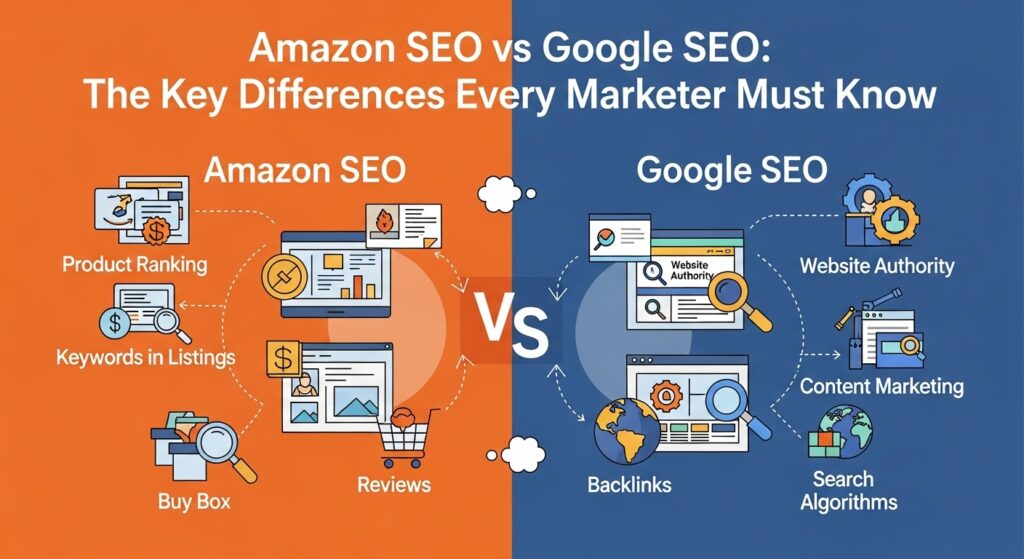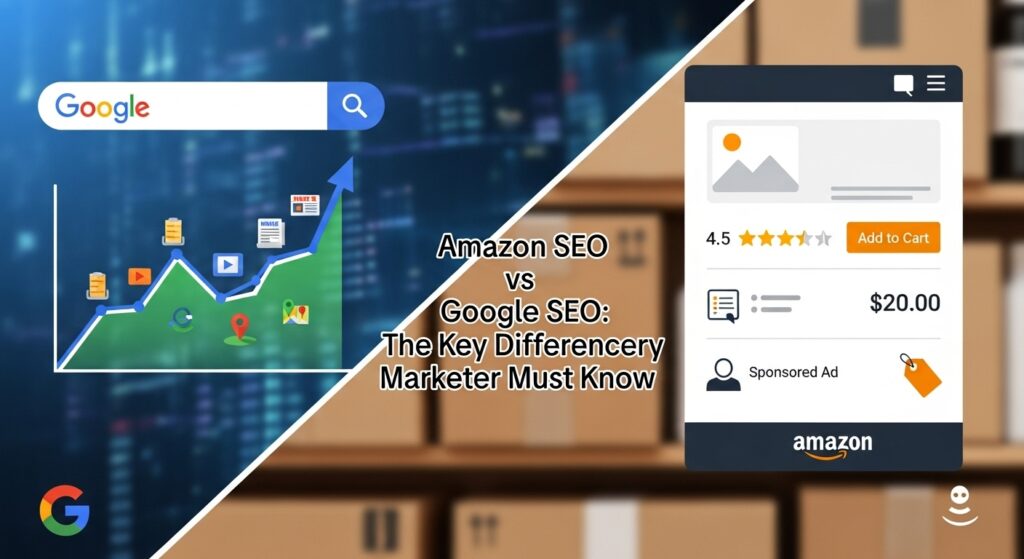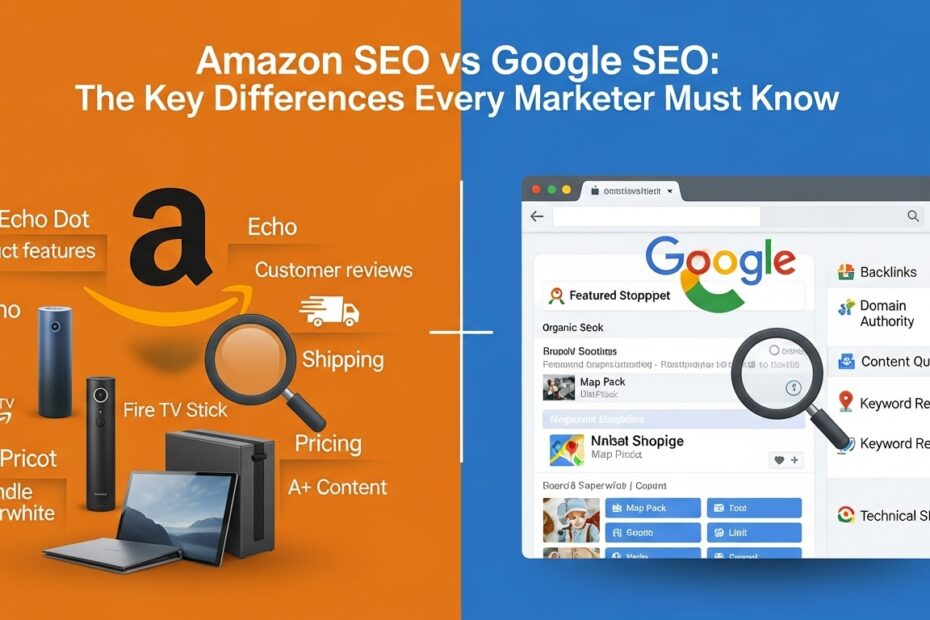Introduction: Two Giants, Two Algorithms, One Goal — Visibility
When discussing search engines, Google is the first name that comes to mind. But here’s a fact most people overlook — Amazon is the world’s largest product search engine, not just an online store. Over 60% of shoppers begin their product searches on Amazon before turning to Google.
That’s why mastering Amazon SEO is now just as crucial as mastering Google SEO.
Both platforms rely on algorithms to decide what users see first — yet their goals, ranking signals, and optimization methods differ dramatically. Understanding these differences could be the edge your business needs to rank higher, sell more, and dominate both worlds.
So today, we’ll dive deep into Amazon SEO vs Google SEO — exploring how each works, what drives visibility, and how marketers can craft strategies that win across both search giants.
1. Amazon SEO and Google SEO: What They Really Mean
Google SEO (Search Engine Optimization) focuses on ranking web pages higher in Google’s search results for informational, navigational, or transactional intent. It’s about visibility across the entire web.
Amazon SEO, on the other hand, focuses specifically on ranking products higher in Amazon’s search results — known as the A9 (and now A10) algorithm. It’s all about sales performance and product visibility inside the Amazon marketplace.
In simple terms:
- Google SEO = Getting clicks.
- Amazon SEO = Getting sales.
Both use keywords and optimization, but their end goals are totally different.
2. The Core Difference: Intent and Algorithm Goals
This is where everything begins — search intent.
| Platform | Primary Goal | Core Intent | Optimization Focus |
|---|---|---|---|
| Deliver the best information | Informational, Navigational, Transactional | Relevance, backlinks, authority | |
| Amazon | Drive sales conversions | Transactional | Product performance, conversion rate, reviews |
Google’s algorithm (powered by RankBrain, BERT, and others) prioritizes relevance, content quality, and authority. It wants to answer a question.
Amazon’s A9/A10 algorithm, however, prioritizes conversion rate, sales history, and buyer satisfaction. It wants to sell a product.
So, if Google asks, “Which page best answers this question?”, Amazon asks, “Which product is most likely to sell?”
That’s a major mindset shift for marketers.
3. How Keywords Work Differently on Amazon vs Google
Keywords are the bridge between search intent and visibility — but the way they work on both platforms is night and day.
Google SEO Keywords:
- Can be short-tail or long-tail (e.g., “best running shoes for men”).
- Focus on semantic search — related meanings and context.
- Often include informational queries like “how to” or “what is.”
Amazon SEO Keywords:
- Always transactional (e.g., “buy running shoes men size 11”).
- Heavily focused on exact match phrases for product titles and bullet points.
- Backend keywords (hidden search terms) are key for extra visibility.
Pro Tip:
While Google rewards keyword diversity and natural flow, Amazon rewards precision and conversion-focused keyword placement in:
- Product Titles
- Bullet Points
- Descriptions
- Backend Search Terms
The tighter your keyword relevance, the better your chance to rank and sell.

4. Ranking Factors: The SEO DNA of Each Platform
Let’s compare how each platform decides what deserves to rank.
| Ranking Factor | Google SEO | Amazon SEO |
|---|---|---|
| Keyword Relevance | Crucial for context and intent | Crucial for product discovery |
| CTR (Click-Through Rate) | Important signal of relevance | Highly impacts ranking and sales |
| Conversion Rate | Indirect factor | Direct ranking factor |
| Content Quality | Determines authority | Determines engagement and conversion |
| Reviews & Ratings | Indirect (for reputation) | Core ranking signal |
| Backlinks | Essential for authority | Not relevant |
| Sales History | Not relevant | One of the strongest ranking signals |
| Price Competitiveness | Not considered | Directly affects ranking and conversion |
| Image Quality | Helps CTR | Vital for conversions and ranking |
So while Google SEO is about authority and information, Amazon SEO is about sales velocity and buyer trust.
5. How Content Strategy Differs Between Amazon and Google
On Google:
Content marketing reigns supreme. You win by publishing blogs, guides, videos, and tutorials that solve problems.
- Optimize H1, H2, and meta tags.
- Build backlinks.
- Increase dwell time and reduce bounce rate.
On Amazon:
Your “content” lives in your product listings — so storytelling meets persuasion.
- Write keyword-rich titles and bullets.
- Use A+ Content (Enhanced Brand Content) with visuals and infographics.
- Focus on conversion triggers — benefits, features, emotional appeal.
On Google, your content earns traffic.
On Amazon, your content earns trust — which earns sales.
6. The Role of Reviews and Ratings in Amazon SEO
Unlike Google, Amazon SEO gives heavy weight to customer feedback.
- High review volume + positive ratings = higher ranking.
- Low ratings = reduced visibility.
Amazon’s algorithm sees reviews as proof of customer satisfaction — and satisfaction equals higher sales potential.
That’s why strategies like:
- Encouraging verified reviews
- Responding to feedback professionally
- Maintaining high seller ratings
… directly influence how high your product appears in search results.
EduKester Tip:
Think of reviews as Amazon’s version of backlinks — they build credibility, trust, and authority.
7. Advertising: SEO’s Power Partner
While both platforms reward organic performance, paid ads boost visibility — and often feed the algorithm.
- Google Ads impacts visibility through CTR and relevance, but doesn’t directly affect organic rankings.
- Amazon PPC Ads (Sponsored Products, Sponsored Brands) directly boost organic ranking because they drive sales velocity.
The more conversions your ad brings, the more Amazon believes your product deserves top placement.
So, running Amazon PPC isn’t just about short-term visibility — it’s about feeding your SEO engine.
8. Data-Driven Optimization: Analytics on Both Platforms
- Google: Uses Google Analytics, Search Console, and tools like Ahrefs or SEMrush. You track metrics like organic traffic, backlinks, and click rates.
- Amazon: Uses Brand Analytics, Advertising Reports, and tools like Helium 10 or Jungle Scout. You track conversion rates, search term performance, and keyword sales impact.
The key difference?
Google’s data tells you what drives traffic.
Amazon’s data tells you what drives sales.
9. Common Mistakes Marketers Make
- Using Google-style content on Amazon: Overloading listings with fluff instead of benefits.
- Ignoring conversion metrics: Amazon rewards sales, not just impressions.
- Neglecting backend keywords: Missing valuable ranking opportunities.
- Failing to test pricing and images: These directly influence Amazon’s A9 algorithm.
Remember, Amazon SEO is a performance game — your listing must not only attract but also convert.
10. The Smart Marketer’s Play: Integrating Amazon and Google SEO
Here’s the winning formula: use both together.
- Rank your Amazon Storefront and product pages on Google using link-building and keyword targeting.
- Use Google Ads or blog traffic to drive visitors to your Amazon listings.
- Retarget Amazon customers with Google Display Ads.
The synergy between Google’s top-of-funnel awareness and Amazon’s bottom-of-funnel conversion creates a 360° marketing strategy that multiplies results.

Data Summary: Amazon SEO vs Google SEO Comparison Table
| Criteria | Amazon SEO | Google SEO |
|---|---|---|
| Goal | Drive product sales | Deliver valuable information |
| Core Algorithm | A9 / A10 | RankBrain / BERT |
| Ranking Basis | Conversion, sales velocity, reviews | Relevance, authority, backlinks |
| Keywords | Transactional, product-focused | Informational, intent-based |
| Optimization Area | Listings, backend, A+ content | Blogs, websites, backlinks |
| Measurement | Conversion rate, CTR, reviews | Organic traffic, domain authority |
| Tools | Helium 10, Jungle Scout, Seller Central | Ahrefs, SEMrush, Google Analytics |
| Ad Impact | Directly improves rankings | Indirectly affects traffic |
| Ideal for | Sellers and brands | Content creators, websites |
Conclusion: Two Platforms, One Mission — Winning Attention
In the end, Amazon SEO vs Google SEO isn’t a battle — it’s a partnership. Both exist to help the right content reach the right audience.
Google helps customers discover your brand.
Amazon helps customers buy from your brand.
For marketers and entrepreneurs, mastering both is non-negotiable. As Kester Terna of EduKester puts it:
“Visibility is power — but conversion is profit. Balance both, and your brand will thrive.”
So, whether you’re optimizing a blog for Google or a product listing for Amazon, remember — the algorithm may differ, but your goal remains the same: Build trust, deliver value, and convert curiosity into loyal customers.
✨ Follow Kester Terna for more in-depth marketing insights, SEO tutorials, and actionable guides for digital growth!
Notes
Meta Description:
Discover the key differences between Amazon SEO and Google SEO. Learn how each algorithm works, what drives visibility, and how to optimize for both to dominate search and sales.
Tags:
Amazon SEO, Google SEO, Amazon Algorithm, Digital Marketing, E-commerce SEO, Search Engine Optimization, Amazon PPC, SEO Strategy, EduKester, A9 Algorithm
Long-Tail Keywords:
- Amazon SEO vs Google SEO
- Difference between Amazon SEO and Google SEO
- How Amazon SEO works
- Google SEO vs the Amazon algorithm
- Amazon SEO strategy 2025
Internal Linking Suggestions:
- Link to article: “Building Your Brand with Amazon Digital Marketing & Brand Registry”
- Link to article: “7 Powerful Amazon Digital Marketing Strategies for Small Business Success”
- Link to article: “Amazon PPC Optimization: Boost Sales with Data-Driven Ads”


